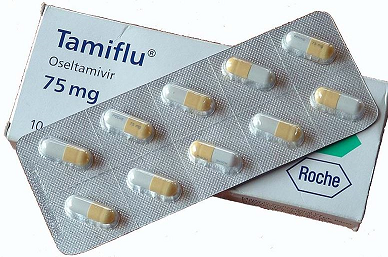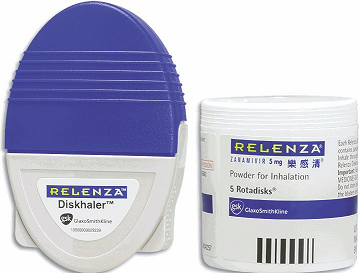|
|
|
Medical Pharmacology Chapter 36: Antiviral Drugs
Antiviral Drugs
Anti-viral drugs with activity against influenza.
Two primary neuraminidase inhibitors (NAIs) are globally licensed for both treatment and influenza prevention.5
The first drug developed in this class was zanamivir (Relenza), followed by oseltamivir (Tamiflu).5
|
|
|
|
|
|
These agents were developed by taking into account the structure of enzyme transition structural states involved in neuraminidase activity.
Zanamivir (Relenza) is administered by oral inhalation; whereas, oseltamivir (Tamiflu) is taken orally.5
These agents are examples of rational drug design, based on the crystalline structure of influenza virus sialidase (neuraminidase).6
The two potent inhibitors so identified proved not only to be inhibitors of the enzyme but also of the influenza virus in cell culture as well as in animal models.6
![]() Oseltamivir (Tamiflu)
Oseltamivir (Tamiflu)
 |
Some influenza variants exhibit resistance to oseltamivir carboxylate and these isolates show hemagglutinin and/or neuraminidase mutations.1
Commonly noted variants which reduce both infectivity and virulence involve mutations in N2 (neuraminidase 2 at position 292) and mutations at N1 (neuraminidase 1 at position 274).
A mutation associated with isolates resistant to oseltamivir (H275Y mutation) is due to a change from the amino acid histidine to tyrosine; however, in this case zanamivir-sensitivity is maintained.2
Some mutations result is loss of sensitivity to both oseltamivir and zanamivir, such as mutation 1223R corresponding to a change from the amino acid isoleucine to arginine.2
![]() Seasonal
influenza A (H1N1) may be nearly 100% oseltamivir resistant, worldwide.
Seasonal
influenza A (H1N1) may be nearly 100% oseltamivir resistant, worldwide.
Susceptibility to oseltamivir in swine influenza or novel H1N1 (nH1N1) remains intact.1
Oseltamivir and zanamivir exhibit activity against both influenza A and influenza B viruses.3
![]() For both
drugs, early administration is important since viral replication is
greatest between days 1-3 following symptom onset.3
For both
drugs, early administration is important since viral replication is
greatest between days 1-3 following symptom onset.3
The duration of the illness may be reduced by about 1-2 days.
Furthermore, influenza severity is also reduced and the likelihood of secondary complications in both adults and children is also decreased.
Oseltamivir has FDA approval for individuals one year and older. By contrast zanamivir is FDA approved in patients who are 7 years or older.3
Oseltamivir is a "prodrug", orally administered, and must be converted to an active form by liver esterases.3
Bioavailability of the carboxylate is about 80% with limited plasma protein binding.1,3
Food does not reduce oseltamivir carboxylate bioavailability, although food does have the benefit of decreasing the likelihood of gastrointestinal side effects.1
Oseltamivir half-life (t½) is about 6-10 hours.
Elimination of oseltamivir and oseltamivir carboxylate, the active form, by the kidney occurs by both glomerular filtration and tubular secretion.1,3
![]() Renal
clearance of oseltamivir may be reduced by 50% when administered in the
presence of probenecid.
Renal
clearance of oseltamivir may be reduced by 50% when administered in the
presence of probenecid.
Importantly, the serum concentration of the active metabolite of oseltamivir, oseltamivir carboxylate, increases with reduced renal function.
Accordingly, oseltamivir dosage may require adjustment in these patients.3
![]() Oseltamivir: Adverse Effects
Oseltamivir: Adverse Effects
Ingestion of oral oseltamivir may be associated with G.I. discomfort, including abdominal discomfort, nausea and infrequently emesis, secondary to local irritation.
These G.I. effects are described as mild to moderate and resolve in about a day or two, despite continual dosing.
As suggested earlier, these effects may be prevented or reduced by administering the drug with food.
Oseltamivir is not associated with clinically important drug-drug interactions.
Furthermore, oseltamivir neither impairs fertility or exhibits teratogenicity in animal studies.
Safety in pregnancy remains uncertain and accordingly this drug is categorized as pregnancy Category C.
![]() Zanamivir (Relenza)
Zanamivir (Relenza)
Zanamivir (Relenza) also inhibits viral neuraminidase, like oseltamivir, thus resulting in viral aggregation at the cell surface and reduction of viral spread.1
Resistance to the action of zanamivir may be due to mutations in viral hemagglutinin and/or neuraminidase.1
Hemagglutinin variants exhibit mutations in or near the receptor binding site.
This localization makes these resistant isolates less dependent on neuraminidase activity for release from cells, at least in vitro and usually retain susceptibility in vivo.
Hemagglutinin variants tend also to be cross-resistant to other neuraminidase inhibitors.
Zanamavir: Absorption and Bioavailability1
Relatively low oral bioavailability of zanamivir (<5%) requires oral inhalation of dry powder, using a lactose carrier.
 |
The inhaler is breath-actuated, requiring cooperation from the patient.
After inhalation of the dry powder about 15% is localized in the lower respiratory tract with about 80% in the oropharynx.
Bioavailability is estimated at between 4% and 17%.
Plasma half-life (t½) of zanamivir is about 2.5-5 hours following oral inhalation.
Plasma half-life (t½) is reduced to about 1.7 hours after IV dosing.
Greater than 90% of zanamivir is found unchanged in the urine.1
![]() Zanamavir: Adverse Effects
Zanamavir: Adverse Effects
Zanamivir is usually well tolerated in ambulatory adults and children with influenza.
In some influenza-infected individuals without established airway disease, orally inhaled zanamivir may cause wheezing and bronchospasm.
![]() In patients with established asthma or COPD
(chronic obstructive airway disease) orally inhaled
zanamivir may induce significant decline in lung
function, including those which result in fatal outcome.
In patients with established asthma or COPD
(chronic obstructive airway disease) orally inhaled
zanamivir may induce significant decline in lung
function, including those which result in fatal outcome.
Accordingly, zanamivir is typically not recommended for use in patients with underlying airway disorders because of this risk.
Zanamivir has not in preclinical studies been demonstrated to exhibit mutagenic, oncogenic, or teratogenic effects.
Zanamivir is classified as pregnancy Category C.
|
|
This Web-based pharmacology and disease-based integrated teaching site is based on reference materials, that are believed reliable and consistent with standards accepted at the time of development. Possibility of human error and on-going research and development in medical sciences do not allow assurance that the information contained herein is in every respect accurate or complete. Users should confirm the information contained herein with other sources. This site should only be considered as a teaching aid for undergraduate and graduate biomedical education and is intended only as a teaching site. Information contained here should not be used for patient management and should not be used as a substitute for consultation with practicing medical professionals. Users of this website should check the product information sheet included in the package of any drug they plan to administer to be certain that the information contained in this site is accurate and that changes have not been made in the recommended dose or in the contraindications for administration. Advertisements that appear on this site are not reviewed for content accuracy and it is the responsibility of users of this website to make individual assessments concerning this information. Medical or other information thus obtained should not be used as a substitute for consultation with practicing medical or scientific or other professionals. |